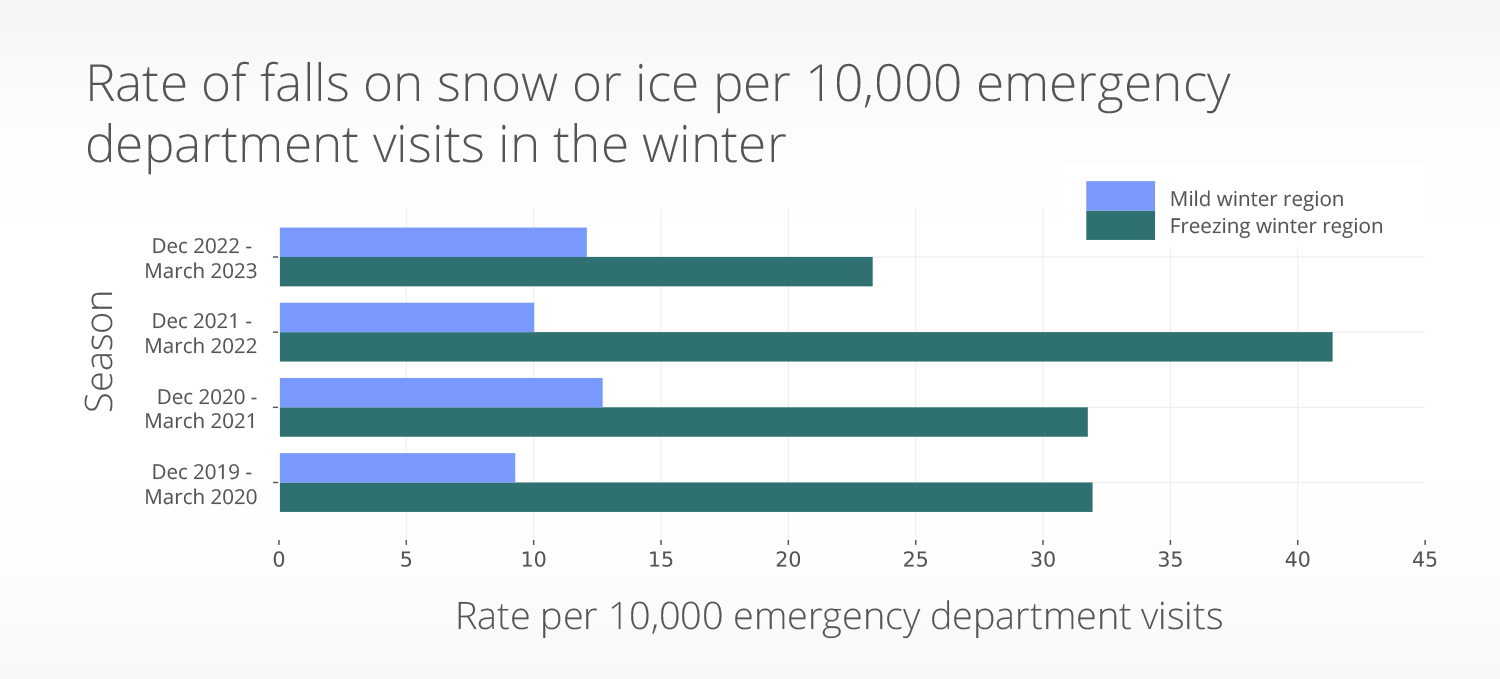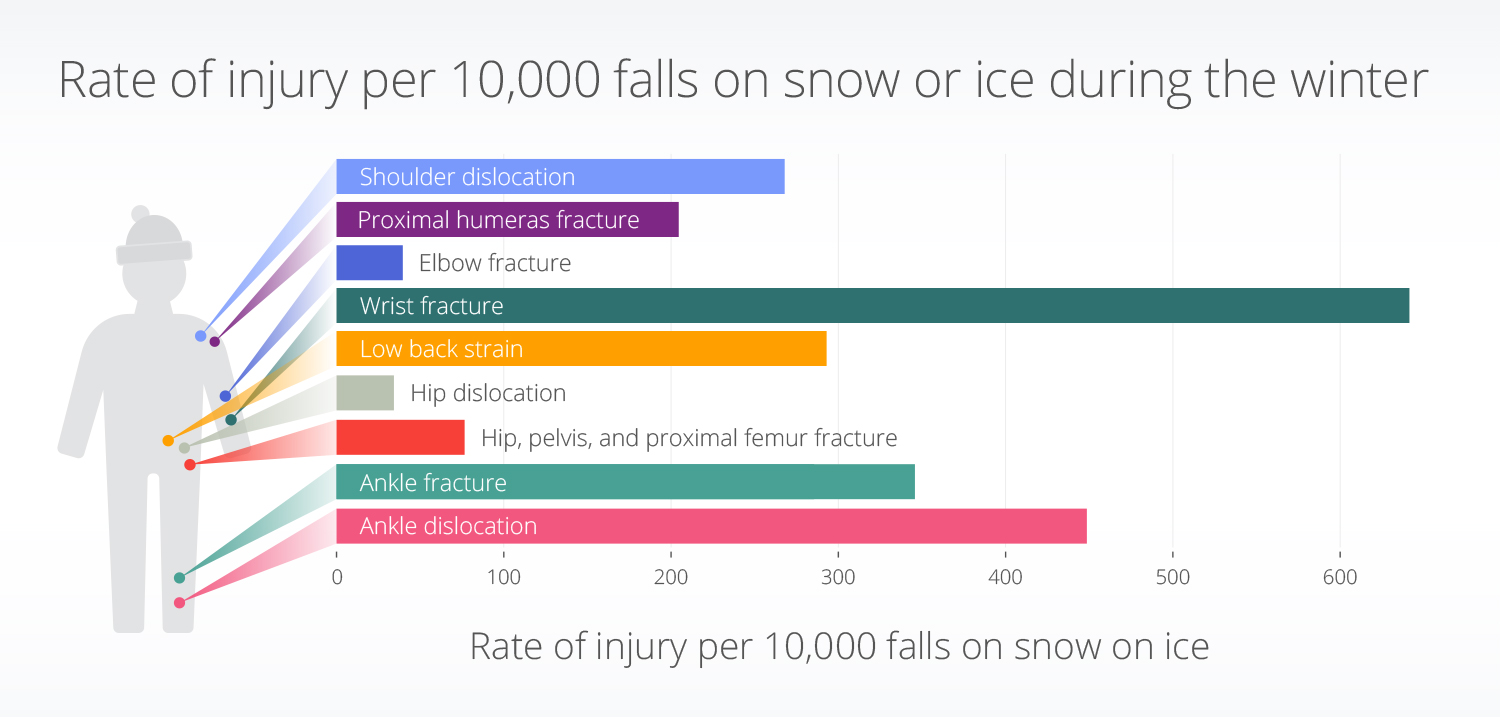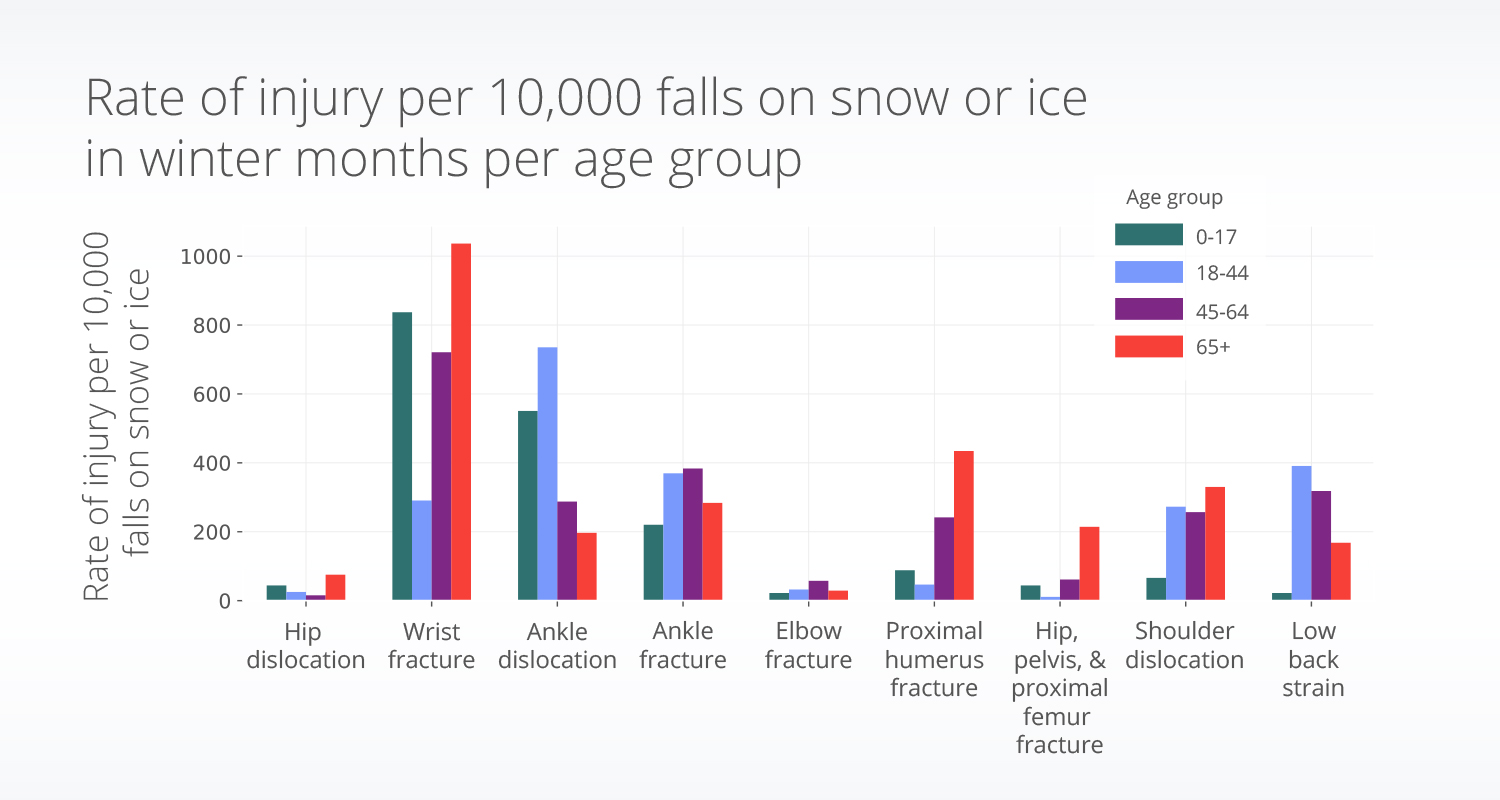- We found 13.1 emergency department visits for falls on snow or ice per 10,000 emergency department visits during wintery months; with 3x higher rates happening in states with freezing temperatures during the winters compared to states with milder winters.
- Wrist fractures were the most common injury associated with a fall on snow or ice. Wrist injuries were most common in the 65 and older population and the population under 18 years old.
- In general, falls on the snow and ice can be dangerous – people should prepare for potentially hazardous weather conditions to avoid falling by wearing sturdy shoes, salting or clearing outdoor surfaces, and knowing techniques to reduce injury if you fall.
Winter is filled with many holidays, travel, and often fun, but it also welcomes colder temperatures and precipitation to much of the US. According to the Federal Highway Administration, more than 70% of the US population lives in areas that get more than five inches of snowfall annually (U.S. Department of Transportation Federal Highway Administration, 2023). 20 states within the US average more than 30 inches of snow a year (NYSkiBlog, 2024) and have average winter temperatures below 32 degrees Fahrenheit (Wisevoter, 2024). Often people think about winter injuries relating to sports or recreation activities such as ice skating or sledding. However, one of the most common injuries that can happen during daily life is falling on ice and snow.
A 2017 study in Philadelphia identified that injuries from falls happened most often during the morning on days with high precipitation, particularly during the time that many people are heading to work or school and before much snow or ice removal takes place (Gevitz et al., 2017). Falls and their related injuries increase healthcare costs, are associated with increased use of prescribed pain medications (Jamieson et al., 2019; Zullo et al., 2018), and increases in hospital staffing needs, especially in in emergency rooms and orthopedic departments (Yeung et al., 2020). For older people, especially women, falls at any point of the year are a major cause of morbidity and mortality (Berková & Berka, 2018). Injuries associated with falls, such as hip fractures, can require surgery, leading to longer recovery time and decreased independence (UCLA Health, 2020).
As more snow and ice blankets the US this month, we wanted to know: 1) how often do falls or slips on the ice or snow occur in the winter; and 2) does the incidence of these injuries vary by places that get more wintry weather than places that don’t?
Methods
We used a subset of Truveta Data to identify patients with emergency department visits during the astrological and meteorological winter months (December to March) from December 1, 2019 to March 31, 2023. (We did not include data later in 2023 in order to compare full astrological and meteorological seasons).
Fall-related emergency department visits in the winter
Of these patients, we identified those for whom the emergency department visit was associated with a fall on ice or snow (defined using ICD10 and SNOMED-CT codes). We calculated the overall and seasonal rates of fall-related emergency department visits per 10,000 emergency department visits. We also looked at differences in the rate of falls for different age groups. Note that these injuries were not related to sports such as skiing, snowboarding, ice skating, or other winter-related sports.
Regional variation in falls on snow or ice
We identified states in Truveta Data that have over 30 inches of snow a year (NYSkiBlog, 2024) and appear in the top 25 states with the coldest weather in the US (Wisevoter, 2024). These states will henceforth be referred to as the freezing winter regions. The states not included in the freezing winter region will be referred to as the mild winter region. We compared the rate per 10,000 of falls on ice or snow in the freezing winter regions to the rate in the mild winter region.
Specific injuries related to falls on snow or ice
We also identified people within this population whose falls were associated with at least one of nine injuries: ankle fracture, ankle dislocation/sprain/strain, fracture of the hip or femur head or neck, fracture of the proximal end of the humerus, fracture of the wrist including the distal ulna and radius, lower back strain, hip dislocation/sprain/strain, elbow fracture, and dislocation/sprain/strain of the shoulder joint. Each injury was assumed to be related to the fall if it was no more than one day before or 14 days after the date of the fall. This timing includes the potential for delayed care.
We calculated the rate of each injury per 10,000 falls seen in the emergency department. Each injury was counted separately, and thus one fall could be counted for multiple injuries.
Results
We included 5,776,772 emergency department visits during winter months from December 2019 to March 2023.
Fall-related emergency department visits in the winter
We found 7,577 emergency department visits associated with falls on snow or ice for 7,433 different people. Overall, there were 13.1 emergency department visits for falls on snow or ice per 10,000 emergency department visits during wintery months.
Patients over the age of 65 accounted for 23.0% of the population with falls on snow or ice and 34.3% of the population was between 45-64 years of age. This was similar between regions with freezing winter temperatures and those with mild winters.
Regional variation in falls on snow or ice
When comparing the number of falls on snow or ice by winter season and region, there was a 3x higher rate of falls in freezing winter regions compared to mild winter regions. This difference was highest in the December 2021-March 2022 timeframe; falls on snow and ice rose to 41.4 emergency department visits per 10,000 emergency department visits in freezing winter regions.

Specific injuries related to falls on snow or ice
We found that 22.5% of the falls on snow or ice were associated with at least one specific injury.
Among falls on snow or ice resulting in emergency department visits, wrist fractures were the most common associated injury (641.4 per 10,000 falls on snow or ice seen in the emergency department).
This was followed by ankle dislocation (447.4 per 10,000) and ankle fracture (345.8 per 10,000).
Injuries to the shoulder girdle, including dislocation (267.9 per 10,000) and fractures of the proximal humerus (the top part of the upper arm bone, 204.6 per 10,000), were also frequent.
The three least common injuries among people included in this study were hip dislocations (34.3 per 10,000 falls on snow or ice), hip fractures (76.5 per 10,000 falls), and elbow fractures (39.6 per 10,000 falls).

People aged 65 and older had the highest age-stratified rate of hip dislocations, wrist fractures, proximal humerus fractures, shoulder dislocations, and hip, pelvis and proximal femur fractures. The second highest rate of hip dislocations and wrist fractures were in the youngest age group (0–17-year-olds).

Discussion
Recent weather storm warnings from the National Weather Service have urged caution when moving around outside – “When venturing outside, watch your first few steps taken on steps, sidewalks, and driveways, which could be icy and slippery, increasing your risk of a fall and injury” (National Weather Service, 2024).
Between December 2019 and December 2023, we found that for every 10,000 emergency department visits from December to March, there were more than 13 emergency department visits due to falls on snow or ice.
Although this may be a small number, over 20% of these falls were associated with a strain, sprain, fracture or dislocation, highlighting the seriousness of these injuries.
As expected, we found much higher rate of falls in regions with freezing winter temperatures compared to those with mild winter temperatures. It is important to understand how widespread these falls and associated injuries are, considering the long-term consequences can include surgery, need for long-term care, possible joint replacement, and alterations to life schedules and activities such as driving or walking.
We found higher rates of injuries to the wrist than other body parts. This likely suggests people trying to catch themselves. The highest rate of injuries to the wrist happened within the over 65 population and in the 0-17-year-old population. We also saw higher rates of low back strains in the 18-44 and 45-64 year old populations, which may be correlated with an increase in falls when shoveling snow.
There are a few limitations associated with this study. First, we selected states with freezing winter temperatures and grouped them together; all other states were also grouped together. There may be periods throughout the winter when states in either group experience extreme winter weather, and these trends vary over time. Further, we recognized that different parts of states can have varying weather patterns. Additional research could stratify to identify differences within a given state. The falls in this study only represent falls due to snow or ice that result in emergency department visits; we may be under-capturing the total falls due to snow or ice for people seeking care outside the emergency room. Further, we relied on ICD10 and SNOMED-CT codes where falls were determined to be related to snow or ice. If a physician did not add these codes to a patient’s medical record, but rather used a generic fall code, they would not be included in this analysis.
Recommendations
In general, prevention of falls on snow or ice is important.
People can consider asking for assistance if needed, wear appropriate footwear, be observant of their surroundings, and slow down to prevent falls when conditions are slick.
If snow or ice is expected, people can prepare outside surfaces where they walk prior to the weather. This could include salting or using something like gravel, kitty litter, or sand to provide traction. Just as important are methods of reducing injury when falling.
When falling, the natural instinct is to put your arms out to stop your fall. This is a major contributor to the wrist, elbow, and shoulder injuries reported here. Instead, if you find yourself falling, keep falling (Harvard Health Publishing, 2023)! Grabbing on to items such as handrails or bushes, for example, can make the situation worse. Instead of tensing up (because who wouldn’t!), loosen up (think of a limp noodle), get your arms out of the way (cross your chest so your whole body absorbs the weight instead of just your arms), and protect your head (Slawek, 2017). One common piece of advice is to fall on your side if you can, but this (of course) can result in injuries such as fractured hips for those with osteoporosis, brittle bones, or people who are elderly.
These suggestions may not prevent all injuries, but they can help you reduce injury and potentially keep you out of the emergency room.
These are preliminary research findings and not peer reviewed. Data are constantly changing and updating. These findings are consistent with data accessed on January 16, 2024.
You can view this study directly in Truveta Studio, including full methodology details and population definitions.
Citations
Berková, M., & Berka, Z. (2018). Falls: A significant cause of morbidity and mortality in elderly people. Vnitrni Lekarstvi, 64(11), 1076–1083.
Gevitz, K., Madera, R., Newbern, C., Lojo, J., & Johnson, C. C. (2017). Risk of Fall-Related Injury due to Adverse Weather Events, Philadelphia, Pennsylvania, 2006-2011. Public Health Reports, 132(1_suppl), 53S-58S. https://doi.org/10.1177/0033354917706968
Harvard Health Publishing. (2023, September 14). How to fall without injury. https://www.health.harvard.edu/staying-healthy/how-to-fall-without-injury
Jamieson, H. A., Nishtala, P. S., Scrase, R., Deely, J. M., Abey-Nesbit, R., Hilmer, S. N., Abernethy, D. R., Berry, S. D., Mor, V., Lacey, C. J., & Schluter, P. J. (2019). Drug Burden Index and Its Association With Hip Fracture Among Older Adults: A National Population-Based Study. The Journals of Gerontology: Series A, 74(7), 1127–1133. https://doi.org/10.1093/gerona/gly176
National Weather Service. (2024). Winter Storm Warning 1/19/2024. https://alerts-v2.weather.gov/#/?id=urn%3Aoid%3A2.49.0.1.840.0.fc529af90e6e522745b75548585baa60e213e85d.001.2
NYSkiBlog. (2024). US Annual Snowfall Map. https://nyskiblog.com/directory/weather-data/us/annual-snowfall-map/
Slawek, E. (2017, February 17). If you have to fall on ice, here’s how not to hurt yourself. Better by Today. https://www.nbcnews.com/better/health/if-you-have-fall-ice-here-s-how-not-hurt-ncna712051
UCLA Health. (2020, November 23). Hip fractures in elderly often lead to bad outcomes. https://www.uclahealth.org/news/hip-fractures-in-elderly-often-lead-to-bad-outcomes#:~:text=Most%20hip%20fractures%20in%20older,urinary%20tract%20infection%20and%20pneumonia
U.S. Department of Transportation Federal Highway Administration. (2023, February 1). Snow and Ice. Road Weather Management Program. https://ops.fhwa.dot.gov/weather/weather_events/snow_ice.htm
Wisevoter. (2024). Coldest States. https://wisevoter.com/state-rankings/coldest-states/#faqs
Yeung, M., Schweitzer, C., Wang, D., Weaver, C., & Lang, E. (2020). Orthomageddon: A retrospective cohort study of weather-dependent variations in emergency department volume in a Canadian city. The American Journal of Emergency Medicine, 38(4), 815–818. https://doi.org/10.1016/j.ajem.2019.12.009
Zullo, A. R., Zhang, T., Beaudoin, F. L., Lee, Y., McConeghy, K. W., Kiel, D. P., Daiello, L. A., Mor, V., & Berry, S. D. (2018). Pain Treatments After Hip Fracture Among Older Nursing Home Residents. Journal of the American Medical Directors Association, 19(2), 174–176. https://doi.org/10.1016/j.jamda.2017.11.008
